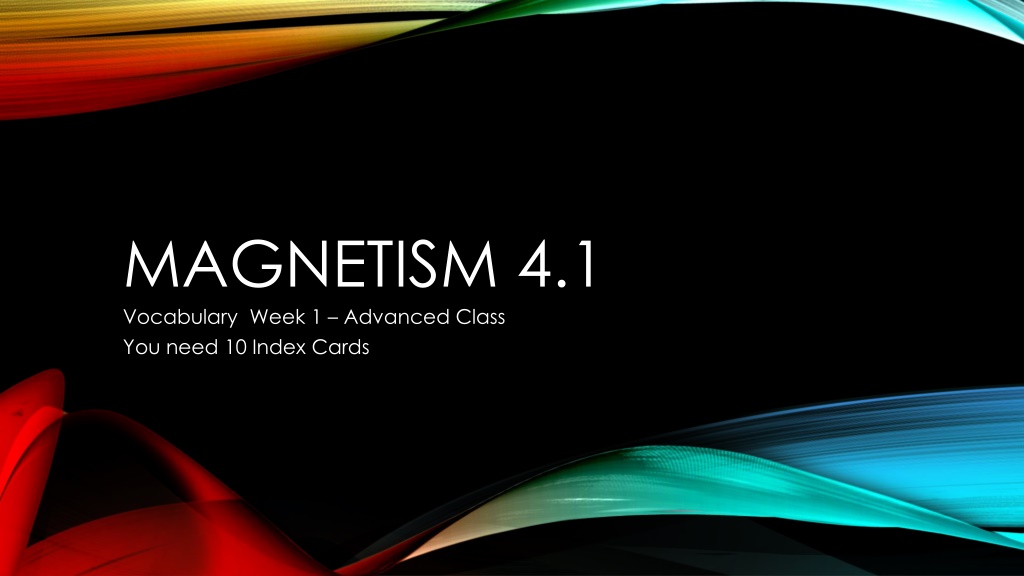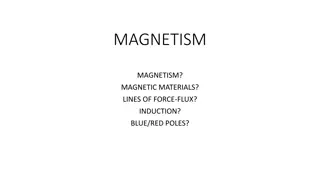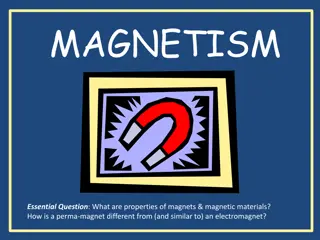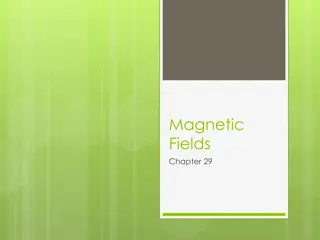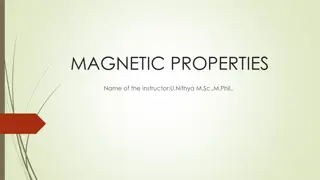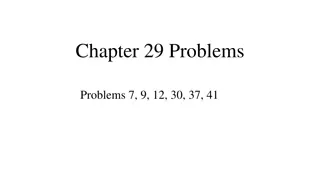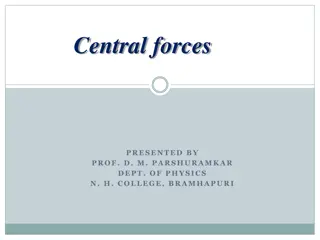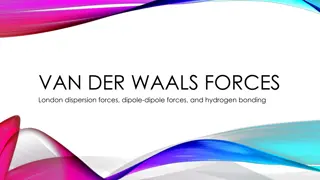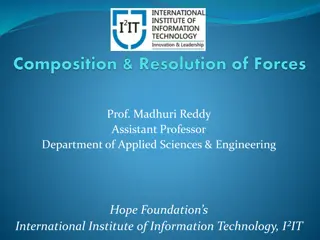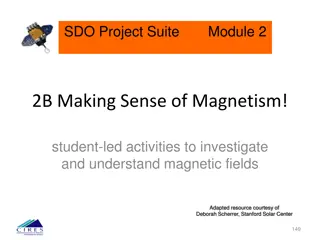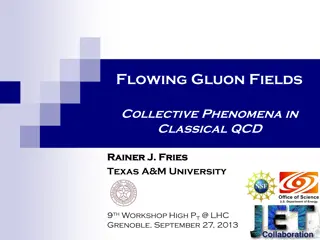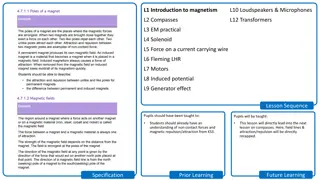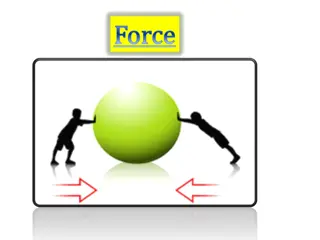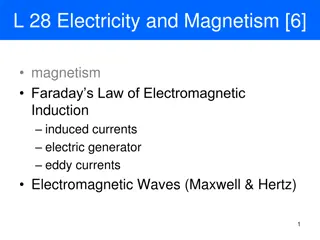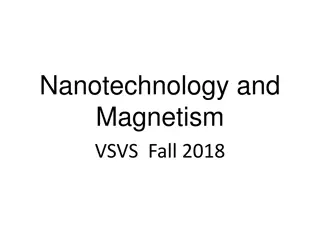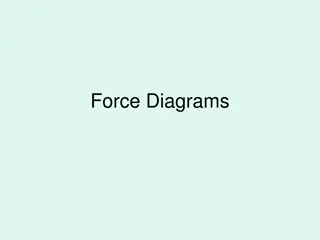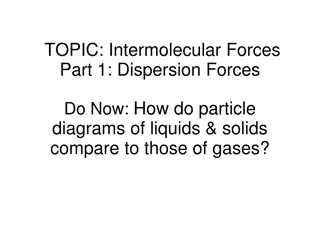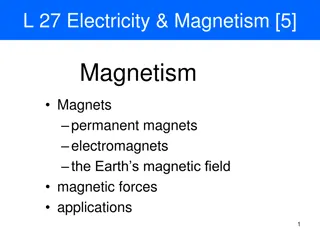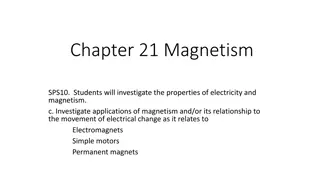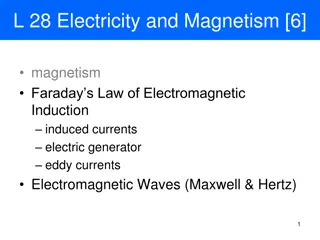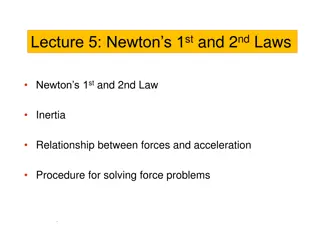Magnetism: Forces, Fields, and Phenomena
Discover the fascinating world of magnetism with insights into magnetic forces, fields, and phenomena. Uncover the mysteries behind magnetic domains and the Earth's magnetosphere. Dive into the science of magnetic materials and their influence on objects in the world around us. Gain a deeper understanding of how magnetic fields are generated and their effects on neighboring objects. Experience the wonder of magnetism as a physical phenomenon produced by the motion of electric charge, resulting in attractive and repulsive forces between objects.
Download Presentation

Please find below an Image/Link to download the presentation.
The content on the website is provided AS IS for your information and personal use only. It may not be sold, licensed, or shared on other websites without obtaining consent from the author.If you encounter any issues during the download, it is possible that the publisher has removed the file from their server.
You are allowed to download the files provided on this website for personal or commercial use, subject to the condition that they are used lawfully. All files are the property of their respective owners.
The content on the website is provided AS IS for your information and personal use only. It may not be sold, licensed, or shared on other websites without obtaining consent from the author.
E N D
Presentation Transcript
MAGNETISM 4.1 Vocabulary Week 1 Advanced Class You need 10 Index Cards
MAGNETISM a physical phenomenon produced by the motion of electric charge, resulting in attractive and repulsive forces between objects. Magnetism is one aspect of the combined electromagnetic force. It refers to physical phenomena arising from the force caused by magnets, objects that produce fields that attract or repel other objects.
MAGNETIC FIELD Magnetic fields are areas where an object exhibits a magnetic influence. The fields affect neighboring objects along things called magnetic field lines. A magnetic object can attract or push away another magnetic object. You also need to remember that magnetic forces are NOT related to gravity. The amount of gravity is based on an object's mass, while magnetic strength is based on the material of which it is made.
Magnetic fields are generated by rotating electric charges, according to HyperPhysics. Electrons all have a property of angular momentum, or spin. Most electrons tend to form pairs in which one of them is spin up and the other is spin down, .
MAGNETIC DOMAIN * A region within a magnetic material in which the magnetization is in a uniform direction. This means that the individual magnetic moments of the atoms are aligned with one another and they point in the same direction. https://www.youtube.com/watch?v=QgwReDkpq6E
MAGNETOSPHERE The magnetosphere is the region that surrounds a planet and the magnetic field of that planet, in which charged particles are trapped and controlled by that planet s magnetic field, rather than the solar magnetic field. More specifically, the Earth s magnetosphere is the region of space where the Earth s magnetic field is confined by the solar wind plasma, blowing outward from the Sun. The magnetosphere prevents most of the particles from the Sun, carried by solar wind, from hitting the Earth. This asymmetrical region surrounds Earth, extending from about one hundred to several thousand kilometers (about 36,000 miles) above the surface.
THE PICTURE ILLUSTRATES THE MAGNETOSPHERE AND LABELS SEVERAL OF ITS KEY COMPONENTS. https://www.youtube.com/watch?v=a76xtylLYRk
MAGNETIC INDUCTION Electromagnetic induction is the production of an electrical potential difference (or voltage) across a conductor situated in a changing magnetic field. Michael Faraday was the first to describe this phenomenon. http://thekidshouldseethis.com/post/80799274938
METALS A metal is a material (an element, compound, or alloy) that is typically hard, opaque, shiny, and has good electrical and thermal conductivity.
FERROUS METALS Ferrous metals and alloys contain iron; non-ferrous materials do not. Examples of Ferrous Metals Mild Steel Used for engineering purposes. Carbon steel Used to make cutting tools such as drill bits. Stainless Steel Made up of Iron, nickel and chromium. Resists staining and corrosion and is used to make cutlery and surgical instrumentation. Wrought Iron Composed of almost 100% iron. Used to make items such as ornamental gates and fencing. Cast Iron Used to manufacture items such as engine blocks and manhole covers.
PERMANENT MAGNET A magnet that retains its magnetism after removal of the magnetizing force. Permanent magnetization of a material involves its electrons and how they move around their nucleus. In a ferromagnetic material, electrons align themselves and spin in the same direction while orbiting their nucleus. This produces a small magnetic field. As more electrons align themselves, the magnetic field becomes stronger. In the case of permanent magnets, electrons tend to stay aligned, unless heated to a high temperature and then cooled.
EXAMPLE OF A PERMANENT MAGNET A "horseshoe magnet" made of alnico, an iron alloy. The magnet is made in the shape of a horseshoe to bring the two magnetic poles close to each other, to create a strong magnetic field that can pick up heavy pieces of iron.
TEMPORARY MAGNET Act like permanent magnets when they are within a strong magnetic field. Unlike permanent magnets however, they loose their magnetism when the field disappears.
MAGNETIC POLES Either of the two ends of a magnet at which the field of the magnet is most intense. Like magnetic poles repel; opposite magnetic poles attract. The poles of a magnet are the two ends of the magnet where the charge is different. One side is north; the other is south. https://www.youtube.com/watch?v=DR9w4koW2EA
